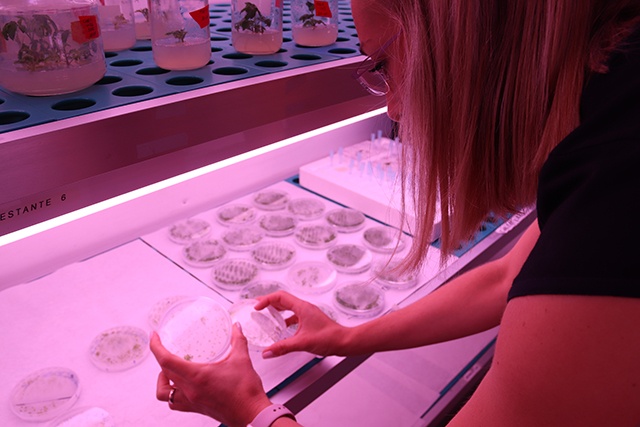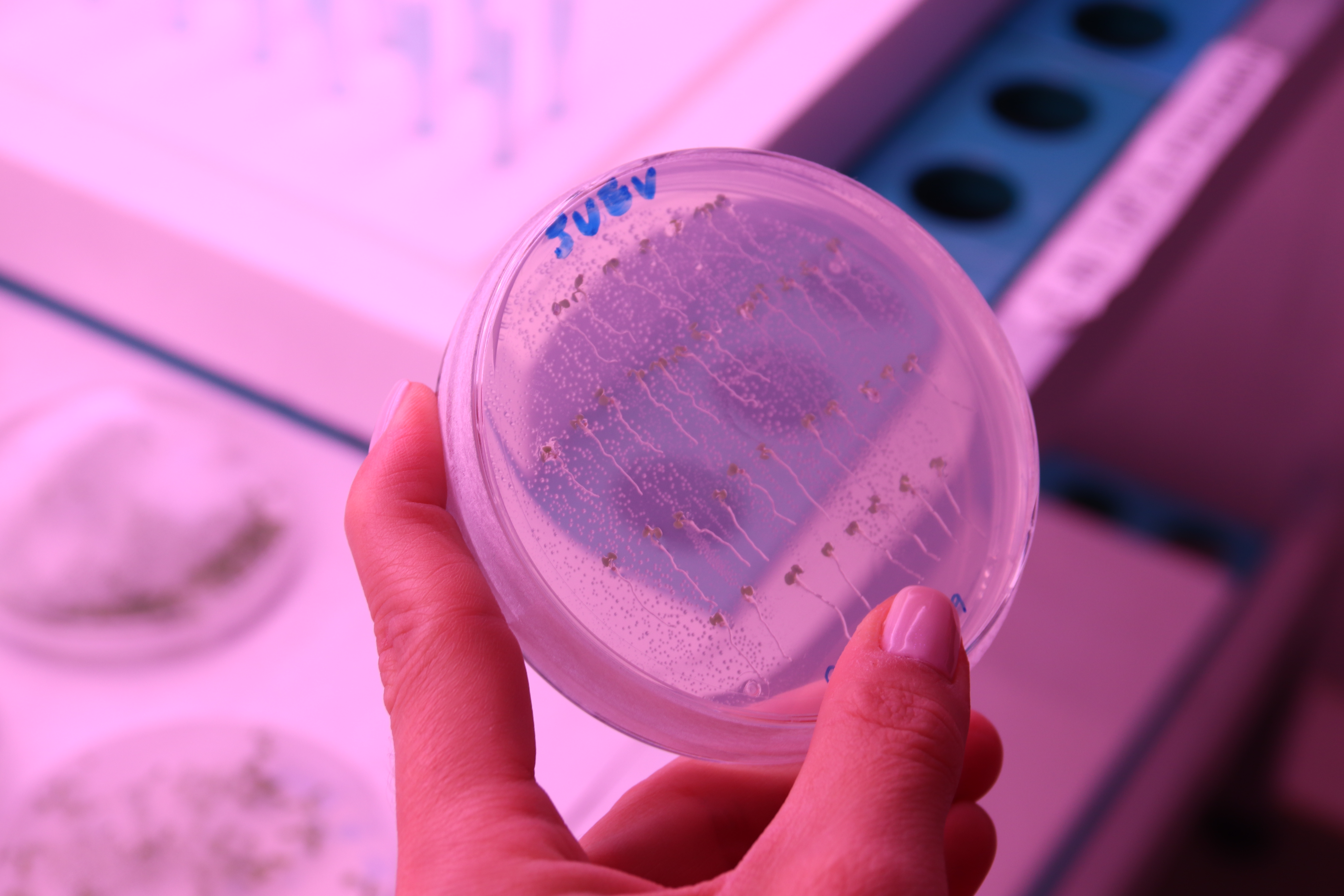Malaga, Spain
September 25, 2019

This protein of plants is essential to developing drought-tolerant crops. - Credit: Universitat Politècnica de València (UPV)
The BAG4 protein regulates the flow of potassium in occlusive cells, which optimizes the use of water by the plant
Researchers of the Universitat Politècnica de València (UPV) and the University of Málaga (UMA) have discovered a new function in the BAG4 plant protein. In the study, they prove that this protein takes part in the regulation of the plant transpiration, the transport of potassium in occlusive cells and thus, the opening of the stomas, the pores located on leaves, from where the plant transpires. This finding is particularly significant for developing crops that are more resistant to drought conditions. Their work has been published in the Plant Physiology journal.
In the study, in which the French center BPMP (Biochimie et Physiologie Moléculaire des Plantes) has also participated, the researchers did an analysis of proteins that are able to physically interact with the channel that regulates how potassium enters the occlusive cells of the plant-known as KAT1-and later they studied how this protein regulated the KAT1 function.
"KAT1 is responsible for the potassium entering the occlusive cells, which directly affects the opening of the stomas and, finally, the plant transpiration. Our aim was focused on knowing how the transport of potassium is regulated in order to improve it in the future," explains Antonella Locascio, researcher at the Institute for Plant Molecular and Cellular Biology (IBMCP), a joint center between UPV and CSIC.
In order to do that, the team of UPV, the University of Málaga and BPMP looked for proteins that directly interact with the KAT1 channel, using Arabidopsis thaliana as a model plant. "We did a biochemical and genetic study of the BAG4 protein to assess its interaction with and effect on the channel. From this study, we discovered that the presence of this protein significantly improves the transport of potassium, contributing to it arriving at the plasma membrane of plants," explains Lynne Yenush, researcher at IBMCP (UPV-CSIC).
According to the researchers, the identification of physiologically significant regulators, in this case, the BAG4 protein, opens up the door to new strategies to obtain plants more resistant to stressful water situations and less vulnerable to the action of several pathogens.
"Stomas are a main structure that regulate the efficiency of the use of water, as well as the entry door of many pathogens that affect agriculture. Knowing the molecular level and how the complex process of stomas opening and closing is regulated can help us to design new crops resistant to pests and drought," concludes José Miguel Mulet, researcher at IBMCP.
Reference
Locascio A, Marques MC, García-Martínez G, Corratgé-Faillie C, Andrés-Colás N, Rubio L, Fernandez JA, Véry AA5, Mulet JM, Yenush LP. BCL2-ASSOCIATED ATHANOGENE4 Regulates the KAT1 Potassium Channel and Controls Stomatal Movement. Plant Physiology. DOI 10.1104/pp.19.00224
Hallan una nueva función en una proteína de las plantas clave para desarrollar cultivos tolerantes a la sequía
El estudio ha sido desarrollado por investigadores de la UMA, la UPV y del centro de I+D+i francés BPMP
Investigadores de la Universidad de Málaga (UMA) y la Universitat Politècnica de València (UPV) han descubierto una nueva función en una proteína de las plantas –la BAG4. En su estudio, demuestran que esta proteína participa en la regulación de la transpiración de la planta, el transporte de potasio en células oclusivas y, por tanto, la apertura de los estomas, los poros situados en la hoja y por donde la planta transpira. Este hallazgo resulta de especial relevancia para el desarrollo de cultivos más resistentes a condiciones de sequía. Su trabajo ha sido publicado en la revista Plant Physiology.
En el estudio, en el que ha participado también el centro francés BPMP (Biochimie et Physiologie Moléculaire des Plantes), los investigadores llevaron a cabo en primer lugar un análisis de proteínas capaces de interaccionar físicamente con el canal que regula la entrada de potasio en las células oclusivas de la planta -llamado KAT1- para posteriormente estudiar cómo esta proteína regulaba la función de KAT1.
“El KAT1 es el responsable de la entrada de potasio en las células oclusivas, lo que incide directamente en la apertura de los estomas y en último término de la transpiración de las plantas. Nuestro objetivo se centró en conocer cómo se regula el transporte de potasio para, en un futuro, poder mejorarlo”, explica Antonella Lacascio, investigadora del Instituto de Biología Molecular y Celular de Plantas (IBMCP), centro mixto de la UPV y el CSIC.
Para ello, el equipo de la UPV, la Universidad de Málaga y de BPMP buscó proteínas que interactuaran directamente con el canal KAT1, utilizando como planta modelo Arabidopsis thaliana. “Llevamos a cabo un estudio bioquímico y genético de la proteína BAG4 para evaluar su interacción y efecto sobre el canal. Y del estudio descubrimos que la presencia de esta proteína mejora significativamente el transporte de potasio, favoreciendo su llegada a la membrana plasmática de las plantas”, señala Lynne Yenush, investigadora también del IBMCP (UPV-CSIC).
En concreto, los profesores José Antonio Fernández y Lourdes Rubio, del Departamento de Botánica y Fisiología Vegetal de la Universidad de Málaga, han participado en esta investigación con la caracterización del papel de la proteína BAG4 a partir de mini-electrodos selectivos de potasio. Técnicas electrofisiológicas para la monitorización de gran potencia, en las que su grupo de I+D+i, tal y como aseguran, son referentes naciones, especialmente en células vegetales.

Cultivos más resistentes
Según destacan los investigadores, la identificación de reguladores fisiológicamente relevantes, en este caso, la proteína BAG4, abre la puerta a nuevas estrategias para obtener plantas más resistentes a situaciones de estrés hídrico y menos vulnerables frente a la acción de diferentes patógenos
“Los estomas, además de ser una estructura fundamental para regular la eficiencia en el uso del agua, son también la puerta de entrada de muchos patógenos que afectan a la agricultura. Conocer a nivel molecular cómo se regula el complejo proceso de apertura y cierre de estomas nos puede ayudar a diseñar cultivos resistentes a plagas y a sequías”, afirma José Miguel Mulet, investigador también del IBMCP (UPV-CSIC).